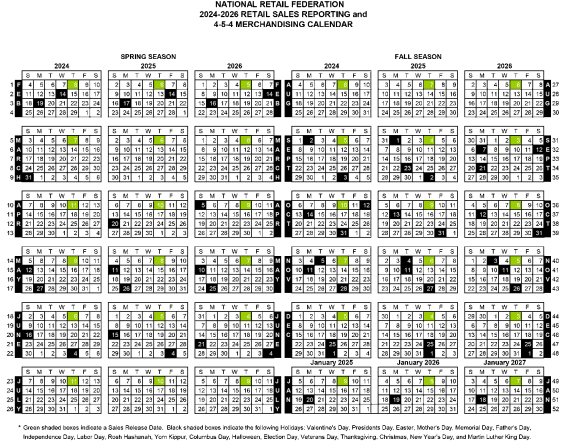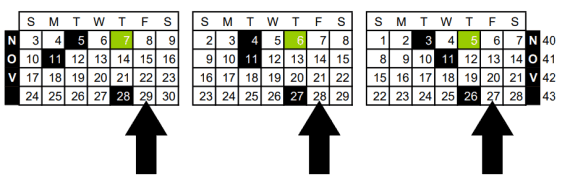
Because the Thirties, retailers have used the 4-5-4 fiscal calendar to streamline and enhance forecasting. This considerably peculiar planning technique might assist fashionable retailers and direct-to-consumer manufacturers.
Ending the 12 months on the identical weekday simplifies comparisons throughout timeframes, aiding in strategic decision-making.
Right here’s how.
4-5-4 Calendar
The 4-5-4 retail calendar is a scheduling framework that divides the 12 months into months of 4 weeks, 5 weeks, and 4 weeks in a repeated sample, making certain every fiscal month begins and ends on the identical weekday. This design aligns gross sales knowledge throughout related durations.
In america, the Nationwide Retail Federation maintains a 4-5-4 retail calendar for its members.

The NRF’s 4-5-4 retail calendar for 2024-to-2026 divides the 12 months into constant three-month quarters, whereby the months have 4, 5, and 4 weeks, respectively. Click on picture to enlarge.
4-5-4 Benefits
The 4-5-4 calendar buildings the fiscal 12 months into constant, comparable durations.
The flexibility to check date ranges — significantly weeks — facilitates smoother planning and estimates of client demand.
I spent almost 10 years because the director of selling and ecommerce for an omnichannel retailer. We relied on a 4-5-4 calendar so closely that I used to be shocked just lately when the revered proprietor of an ecommerce enterprise instructed me he’d by no means heard of it.
Planning. For buying and advertising and marketing departments, the 4-5-4 calendar is a roadmap via retail’s inherent highs and lows.
The calendar acknowledges the predictable swings in client purchasing, optimizing, if you’ll, for these crucial high-traffic home windows, equivalent to main holidays and seasonal shifts.
Think about planning for the Christmas purchasing season, which incorporates Black Friday. On the Gregorian calendar, Black Friday shifts between November 23 and 29, relying on the 12 months.
This variability makes it difficult to precisely evaluate year-over-year gross sales for November as a result of the variety of post-Black Friday purchasing days in that month can differ.
Enter the 4-5-4 calendar, which teams weeks right into a constant sample, whereby every fiscal month begins and ends on the identical day of the week yearly. With this setup, Black Friday falls within the final week of November with precisely one purchasing day afterward. Within the Gregorian calendar, the variety of purchasing days after Black Friday varies from one to a few.

With the 4-5-4 calendar, Black Friday happens within the final week of November and is adopted by precisely one purchasing day that month, simplifying annual efficiency comparisons. Picture: NRF.
This 4-5-4 consistency permits for direct, apples-to-apples comparisons of the crucial vacation purchasing interval from one 12 months to the subsequent. Retailers can precisely measure the affect of Black Friday promotions and the following purchasing days till the top of November with out the distortions brought on by Thanksgiving Day’s floating date. Easter presents related challenges.
Procurement and advertising and marketing groups can forecast demand, plan stock, and set advertising and marketing methods extra exactly.
Evaluation. Adopting the 4-5-4 calendar introduces a degree of standardization that’s useful for the analytical rigor required in retailing and ecommerce.
This standardization simplifies conducting quarter-over-quarter and year-over-year analyses most often. Nonetheless, there’s a snag. Since a 12 months is a bit longer than 52 weeks, the 4-5-4 calendar has a “intercalary year” the place a 53rd week is added. Thus, the comparability fails each 5 or 6 years. Nonetheless, it’s much more standardized than the Gregorian different.
Backside line, retailers can evaluate efficiency metrics equivalent to gross sales, web site site visitors, and stock turnover with out the shifting variety of purchasing days.
4-5-4 Challenges
The 4-5-4 calendar presents challenges in coaching, know-how, and monetary duties.
- Coaching and training. The 4-5-4 system requires coaching — explaining what it’s, the way it works, and how you can use it. Accounting people will doubtless choose it up faster than entrepreneurs.
- Technological integration. Transitioning to a 4-5-4 fiscal calendar might require substantial changes to retail administration software program, analytics instruments, and back-office programs — though the shift is a chance to audit present applied sciences.
- Monetary duties. A 4-5-4 methodology can have an effect on obligations that align with the Gregorian calendar, equivalent to tax reporting and compliance. Companies should plan how their fiscal reporting will interface with tax and different necessities, presumably necessitating changes to accounting practices or further reconciliation steps. Tax professionals skilled with non-standard fiscal durations can present essential insights.
Greatest Possibility?
Budgetary instruments such because the 4-5-4 retail calendar have been round for years. If planning and comparisons pose no problem for your online business, focus elsewhere. In any other case, switching the calendar is perhaps simply what you want.